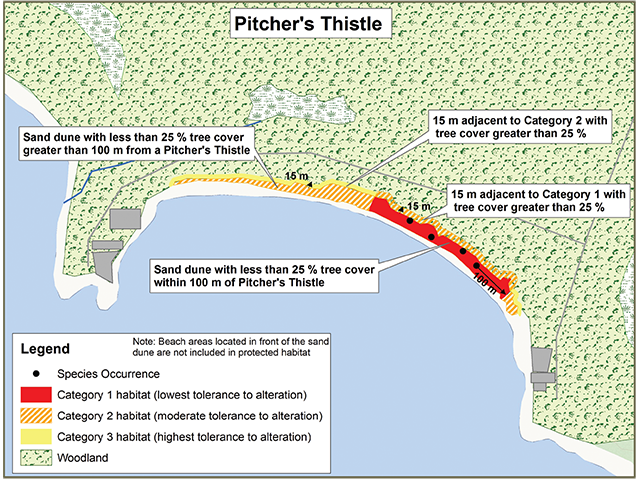Habitat Protection Summary for Pitcher’s Thistle
This document outlines a brief description of the area that is protected as habitat for Pitcher’s Thistle through a habitat regulation under the Endangered Species Act.
The Pitcher’s Thistle is a perennial plant that flowers only once in its lifetime. It lives on sand dunes along the coasts of the Great Lakes that have open, dry, loose sand with sparse or no vegetation immediately surrounding or shading the thistles. The species was assessed by the Committee on the Status of Species at Risk in Ontario (COSSARO) and listed as threatened in June 8, 2011. More information about the species’ status and where it occurs in Ontario can be found at the Pitcher’s Thistle page.
Brief description of the habitat regulation
The habitat regulation for Pitcher’s Thistle protects sand dunes with less than 25% tree cover, where Pitcher’s Thistle exists. Areas of natural vegetation such as a treed sand dune, or woodland, within 15 metres from the edge of a sand dune, where tree cover is greater than 25%, are also protected.
Beach areas which may be located in front of the sand dunes are not included within protected habitat. However, activities that occur in this area that have a reasonable potential to negatively impact regulated habitat could require authorization under the ESA.
Habitat categorization
The following text indicates how the species’ habitat would be categorized, as per the policy Categorizing and Protecting Habitat under the Endangered Species Act.
Category 1 (Red)
- The area of a sand dune with less than 25% tree cover that is within 100 metres of where Pitcher`s Thistle is found.
Category 2 (Orange)
- The area of the sand dune with less than 25% tree cover that is greater than 100 metres from the species
- The area within 15 metres from the outer boundary of the sand dune identified as Category 1 where tree cover is greater than 25%, such as a treed sand dune or a woodlot
Category 3 (Yellow)
- The area within 15 metres from the outer boundary of the sand dune identified as Category 2 where tree cover is greater than 25%, such as a treed sand dune or a woodlot
Sample application of the habitat regulation

Enlarge sample application of the habitat regulation (PDF)
This content is summary only. For accurate reference of the regulation, please view Ontario Regulation 242/08 on e-laws.
This protection applies to areas that were used by the species anytime in the past five years. If the species was last observed more than five years ago, the MNRF considers the species to still be present at the site unless one of the following occurs:
- five consecutive years of MNRF-approved surveys have been conducted and indicate that the species no longer exists at the site, or
- the species has been formally designated as extirpated at the specific site.
The regulation applies where the species is found in the lower-tier municipality of Kincardine within Bruce County, the lower-tier municipality of Lambton Shores within Lambton County, the geographic townships of Dawson and Robinson within the district of Manitoulin, and the single-tier municipalities of Burpee and Mills, Central Manitoulin, Tehkummah, Northeast Manitoulin and the Islands and Cockburn Island within the district of Manitoulin.
Supporting rationale
- Pitcher’s Thistle is highly restricted to and depends on sand dune habitat to carry out its life processes.
- Pitcher’s Thistle is dependent upon the dynamic nature of the sand dune. Maintaining the integrity of the entire open sand dune is critical to Pitcher’s Thistle populations.
- Protecting a treed area 15 metres adjacent to a sand dune will prevent the destabilization of the dune and maintain the natural boundary. This will support the ecological conditions required for the persistence and long-term sustainability of Pitcher’s Thistle.
- The five-year period allows for sufficient time to determine that the site is no longer being used based on the species’ lifespan and detectability.
Activities in Pitcher’s Thistle habitat
Activities in regulated habitat can continue as long as the function of these areas for the species is maintained and individuals of the species are not killed, harmed, or harassed. Activities are evaluated on a case-by-case basis for compatibility with regulated habitat.
Generally compatible
- Hiking on or maintaining existing designated walking trails
- Yard work such as maintenance of existing lawns and gardens
- Renovations of small structures such as sheds or decks
Generally not compatiblefootnote *
- Trampling, cutting, raking or removal of native dune grassland vegetation or mining, grading, raking, manual removal or mechanical removal of sand
- Large-scale construction, such as a housing development or roads
- Replacement of natural dune and beach shoreline with artificial stabilization or erosion control structures such as breakwalls or the construction of piers or gryones
- Intensive recreational use of dunes (e.g., motorized vehicles, such as trucks and ATV’s)
Landowners with species at risk habitat on their property may be eligible for funding programs that support stewardship activities to help protect and recover species at risk, such as the Species at Risk Stewardship Fund or the Species at Risk Farm Incentive Program. Visit Species at risk or contact your local MNRF office for more information.
Key terms
- Sand Dune:
- active rolling sand hills formed by shoreline and wind processes with little to no accumulation of organic materials and variable vegetation cover.
Footnotes
- footnote[*] Back to paragraph If you are considering an activity that may not be compatible with regulated habitat, please contact your local MNRF office for more information. Please note that any activity that occurs outside of regulated habitat but that has a reasonable potential to negatively impact regulated habitat could require authorization under the ESA.